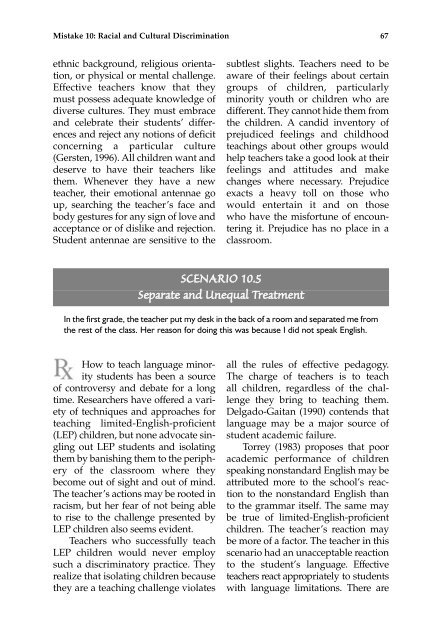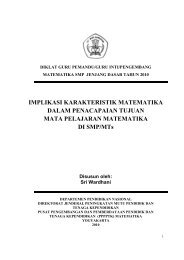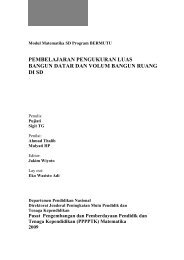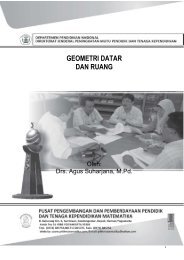25 Biggest Mistakes Teachers Make and How to Avoid Them
25 Biggest Mistakes Teachers Make and How to Avoid Them
25 Biggest Mistakes Teachers Make and How to Avoid Them
You also want an ePaper? Increase the reach of your titles
YUMPU automatically turns print PDFs into web optimized ePapers that Google loves.
Mistake 10: Racial <strong>and</strong> Cultural Discrimination<br />
ethnic background, religious orientation,<br />
or physical or mental challenge.<br />
Effective teachers know that they<br />
must possess adequate knowledge of<br />
diverse cultures. They must embrace<br />
<strong>and</strong> celebrate their students’ differences<br />
<strong>and</strong> reject any notions of deficit<br />
concerning a particular culture<br />
(Gersten, 1996). All children want <strong>and</strong><br />
deserve <strong>to</strong> have their teachers like<br />
them. Whenever they have a new<br />
teacher, their emotional antennae go<br />
up, searching the teacher’s face <strong>and</strong><br />
body gestures for any sign of love <strong>and</strong><br />
acceptance or of dislike <strong>and</strong> rejection.<br />
Student antennae are sensitive <strong>to</strong> the<br />
SCENARIO 10.5<br />
Separate <strong>and</strong> Unequal Treatment<br />
subtlest slights. <strong>Teachers</strong> need <strong>to</strong> be<br />
aware of their feelings about certain<br />
groups of children, particularly<br />
minority youth or children who are<br />
different. They cannot hide them from<br />
the children. A c<strong>and</strong>id inven<strong>to</strong>ry of<br />
prejudiced feelings <strong>and</strong> childhood<br />
teachings about other groups would<br />
help teachers take a good look at their<br />
feelings <strong>and</strong> attitudes <strong>and</strong> make<br />
changes where necessary. Prejudice<br />
exacts a heavy <strong>to</strong>ll on those who<br />
would entertain it <strong>and</strong> on those<br />
who have the misfortune of encountering<br />
it. Prejudice has no place in a<br />
classroom.<br />
In the first grade, the teacher put my desk in the back of a room <strong>and</strong> separated me from<br />
the rest of the class. Her reason for doing this was because I did not speak English.<br />
<strong>How</strong> <strong>to</strong> teach language minority<br />
students has been a source<br />
of controversy <strong>and</strong> debate for a long<br />
time. Researchers have offered a variety<br />
of techniques <strong>and</strong> approaches for<br />
teaching limited-English-proficient<br />
(LEP) children, but none advocate singling<br />
out LEP students <strong>and</strong> isolating<br />
them by banishing them <strong>to</strong> the peri phery<br />
of the classroom where they<br />
become out of sight <strong>and</strong> out of mind.<br />
The teacher’s actions may be rooted in<br />
racism, but her fear of not being able<br />
<strong>to</strong> rise <strong>to</strong> the challenge presented by<br />
LEP children also seems evident.<br />
<strong>Teachers</strong> who successfully teach<br />
LEP children would never employ<br />
such a discrimina<strong>to</strong>ry practice. They<br />
realize that isolating children because<br />
they are a teaching challenge violates<br />
all the rules of effective pedagogy.<br />
The charge of teachers is <strong>to</strong> teach<br />
all children, regardless of the challenge<br />
they bring <strong>to</strong> teaching them.<br />
Delgado-Gaitan (1990) contends that<br />
language may be a major source of<br />
student academic failure.<br />
Torrey (1983) proposes that poor<br />
academic performance of children<br />
speaking nonst<strong>and</strong>ard English may be<br />
attributed more <strong>to</strong> the school’s reaction<br />
<strong>to</strong> the nonst<strong>and</strong>ard English than<br />
<strong>to</strong> the grammar itself. The same may<br />
be true of limited-English-proficient<br />
children. The teacher’s reaction may<br />
be more of a fac<strong>to</strong>r. The teacher in this<br />
scenario had an unacceptable reaction<br />
<strong>to</strong> the student’s language. Effective<br />
teachers react appro priately <strong>to</strong> students<br />
with language limitations. There are<br />
67





